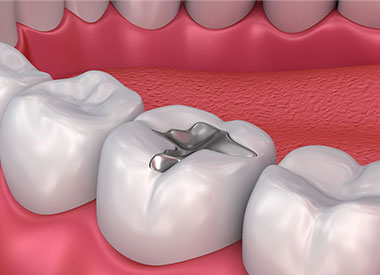Dental Fillings
Dental fillings are used to substitute a portion of a tooth that has been impacted by decay or worn away due to trauma. Restoring the tooth with a filling helps to protect the tooth's integrity and prevent future damage, which can help you avoid losing the tooth in the long run. Traditionally, fillings were made of metal, but they can now be made of a variety of materials such as metal amalgam, porcelain, and composite resin. The application of a dental filling is now virtually painless, thanks to the use of local anesthetics. To make an appointment for a filling, use the dentist near me search to locate the nearest Dental location. We can help you with any dental symptoms, diagnostics, and treatments.
Common Filling Materials:
Fillings were always made of metal, usually gold or silver, many years ago. Metal fillings were and continue to be very durable, but many patients dislike how visible they are in the mouth. Thankfully, tooth-coloured fillings, such as composite resin and porcelain, are now available, making fillings much less visible in patients' mouths. Based on the location of the tooth that needs filling, your budget, the size of the cavity, and your personal preferences, your dentist can advise you on the best material for your filling.
Metal Amalgams:
Metal fillings are still the most long-lasting option. Gold fillings can last for decades or even a lifetime, while silver fillings can last for 10 years or more. Many patients still opt for metal fillings for cavities and chips in their back molars because these teeth are not visible when they smile. In most cases, metal fillings are also the most affordable option. Most are now made from a combination of metals such as mercury, silver, and tin.
Composite resin:
Composite resin fillings are made of a specialised epoxy material with silica or ceramic for strength. They can be specially coloured to match your natural tooth colour, making them a popular choice for front teeth and other areas that are visible when you smile.
When inserting a composite filling, your dentist does not have to remove as much tooth material as when inserting a metal filling. As a result, composite fillings are more likely to be recommended by your dentist for larger cavities. One disadvantage of composite fillings is that they do not last as long as metal fillings. Fillings may need to be replaced every ten years or sooner.
Porcelain:
Inlays are another term for porcelain fillings. They are the most expensive filling option, but they last longer than composite resin fillings. Inlays are more commonly used by dentists to repair worn or abraded teeth than to treat cavities.
Make an appointment with a dentist right away if you have a toothache, sensitivity, bad breath, or other symptoms of a cavity or tooth damage. Once your dentist has determined the extent of your cavity, chip, or crack, they can assist you in determining the best filling material for your needs.

